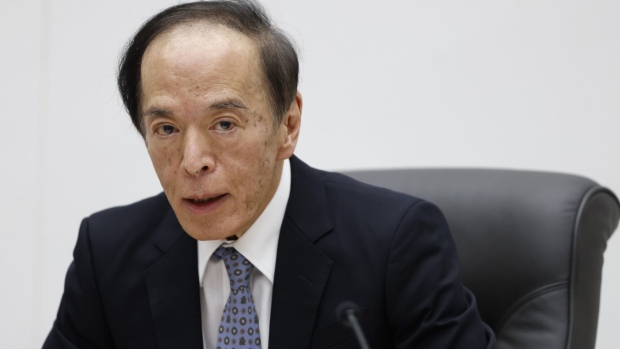Nov 5, 2023
BOJ’s Ueda Reiterates Gradual Progress Toward Price Goal Seen
, Bloomberg News

(Bloomberg) -- Bank of Japan Governor Kazuo Ueda signaled it’s unlikely policymakers will have the data needed to declare by year-end that it’s time to put an end to negative interest rates, as he continues to monitor whether a wage-inflation cycle will materialize.
“It’s impossible to say the chances are zero, in truth,” that authorities might be able to discern within the year that the BOJ’s 2% inflation target has been met, Ueda told reporters in Nagoya, Aichi Prefecture, on Monday. “But, as I just said, there are less than two months” left in 2023, he said, implying the likelihood of such an outcome is quite low.
The yen traded in a narrow range and held an intraday decline of 0.1% at about 149.50 versus the dollar after Ueda’s comments. Bonds rallied, catching up with moves in global rates as Japanese markets reopened after a long weekend. The benchmark 10-year yield dropped five basis points to 0.87%.
Ueda, the first academic to serve as BOJ chief, laid out various possibilities for attaining the goal, noting it could be next year and then again it might be the year after that. “Theoretically,” such a judgment could come at any meeting, he said.
In September, Ueda kindled market speculation over an early policy shift by saying that the chances weren’t zero that attainment of the price goal might be determined by year-end. But he later explained that he merely meant to ensure that the board considered all possibilities in their discussions.
Earlier Monday, the governor continued to cautiously hint that gradual progress is being made toward achieving the bank’s inflation target, in a largely dovish policy message that left open the door as to when it may come time for normalization.
“The likelihood of realizing the outlook for achieving the price stability target of 2 percent seems to be gradually rising,” Ueda said in a speech to local business leaders in Nagoya. However, as there are high uncertainties over wage growth and other factors, “sustainable and stable achievement of the price stability target is not yet envisaged with sufficient certainty at this point.”
Ueda’s rhetoric has gradually changed as he indicates slightly more confidence about the likelihood of achieving the goal. Adding to that are the bank’s latest inflation forecasts, which project price growth will exceed the goal once again next year. After the September policy meeting, Ueda said the stable inflation target wasn’t in sight, without any reference to growing certainty.
The governor’s messaging may pave the way for a smooth transition to normalization when the time comes, allowing Ueda to avoid the sort of criticism lodged at his predecessor amid perceptions that market players were continually surprised by policy tweaks under the previous regime.
Read: BOJ’s Ueda Gets Reality Check on Yen in March to Normalization
Ueda continued to stress high uncertainties surrounding the economic outlook. The bank needs to confirm that a wage-inflation virtuous cycle will kick in, with businesses raising prices to help them also boost compensation for workers.
“There have been new developments in some firms’ price-setting behavior,” Ueda said. “However, many argue that, unlike raw material costs, increases in wages and other indirect costs are difficult to pass on to selling prices.”
The BOJ tweaked its yield curve control mechanism on Oct. 31 to address the potential side effects of monetary easing, a move some economists interpreted as a tiptoe toward normalization. Some 70% of analysts forecast a step toward tightening by April, according to a Bloomberg survey ahead of the October policy gathering.
The BOJ sharply raised its price outlook for next fiscal year to 2.8%, well above what economists were expecting. The upgrade meant that the bank is expecting inflation beyond its 2% goal for three consecutive years, an accomplishment the nation hasn’t seen since 1992.
--With assistance from Brett Miller.
©2023 Bloomberg L.P.






